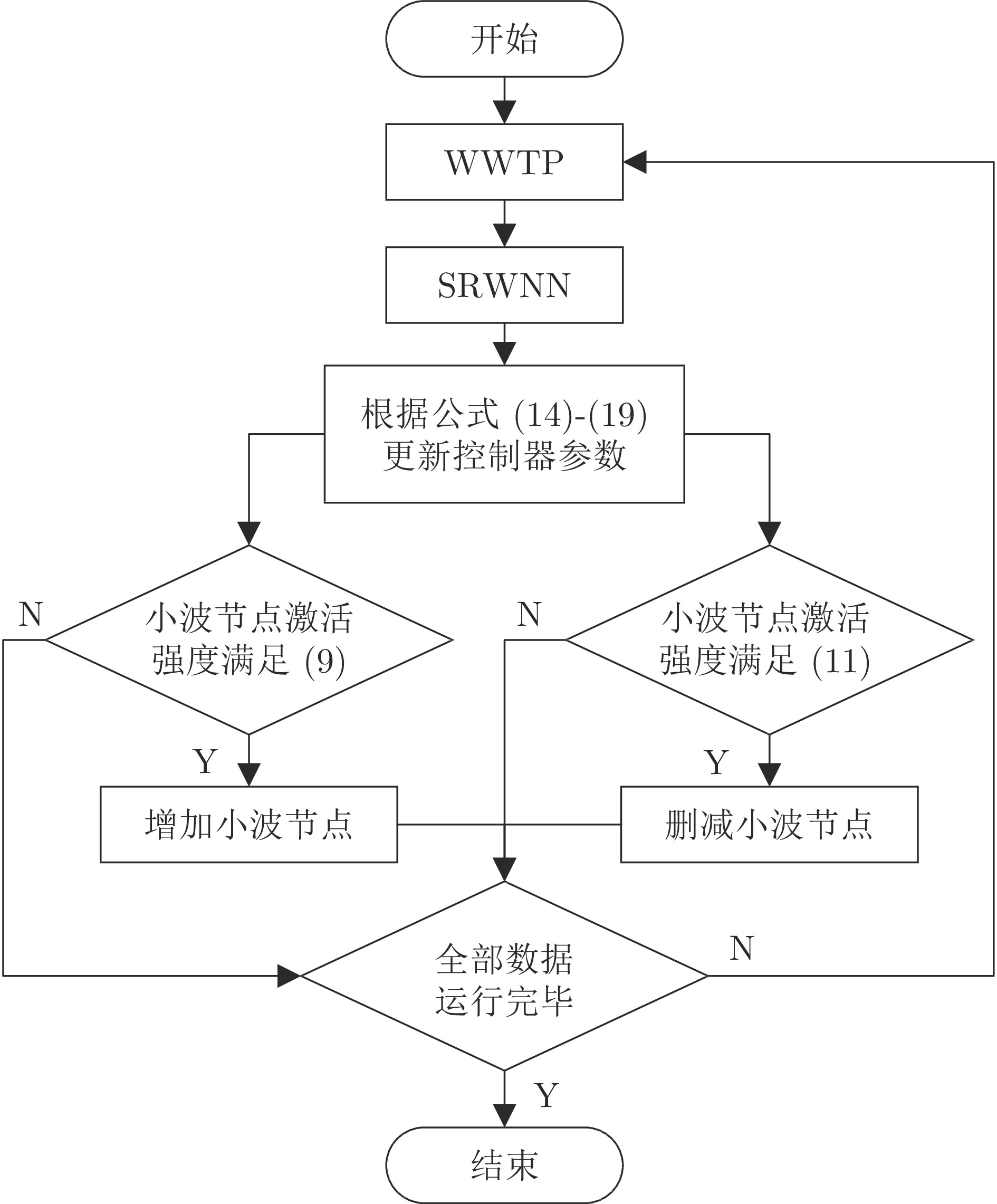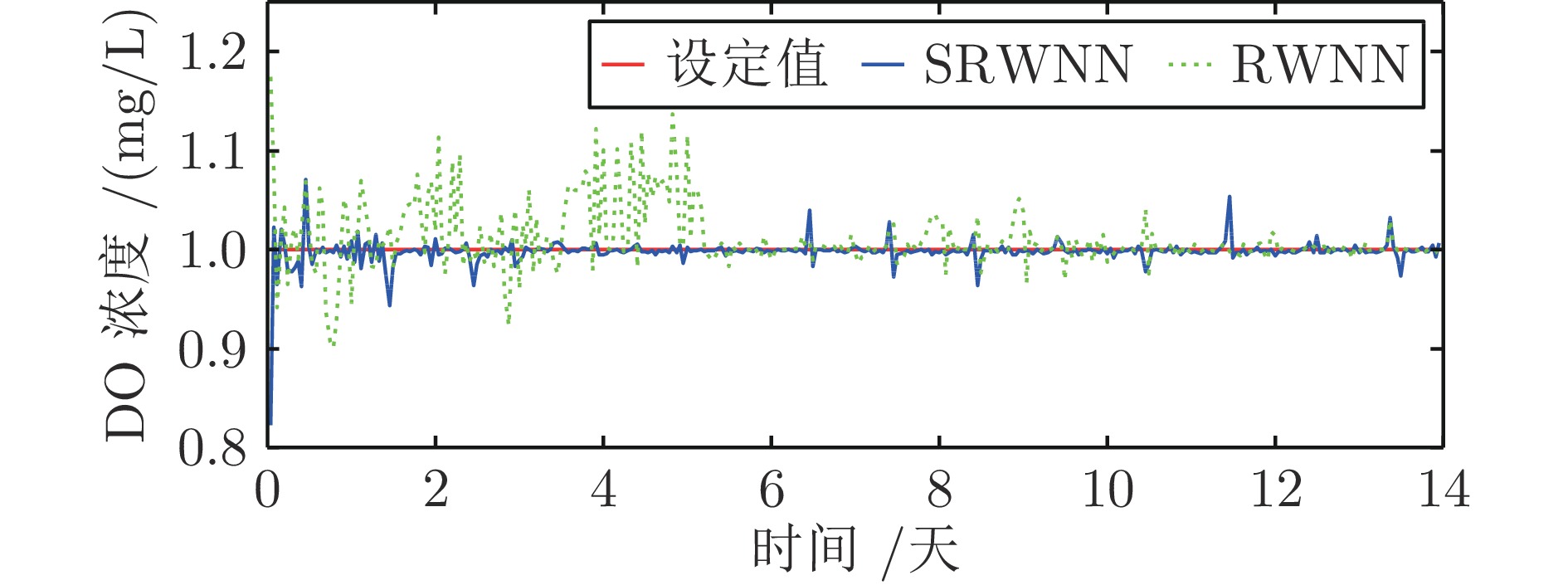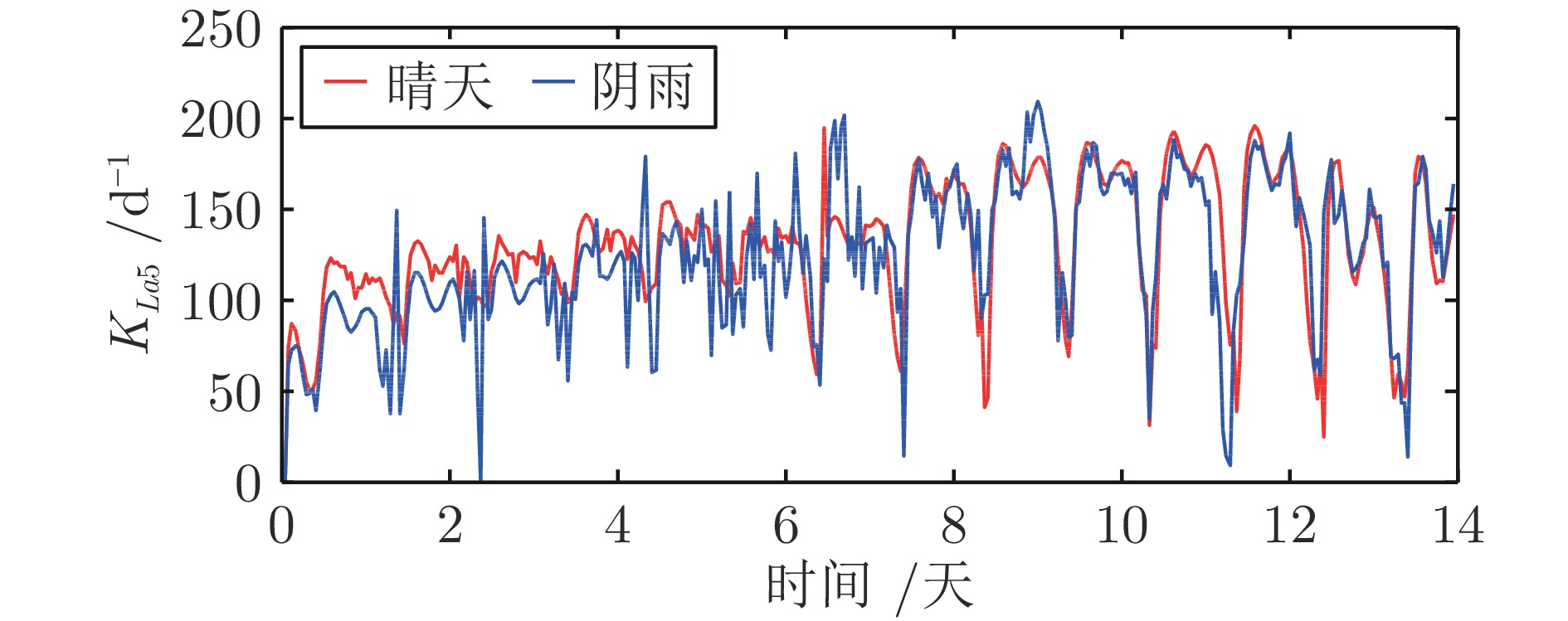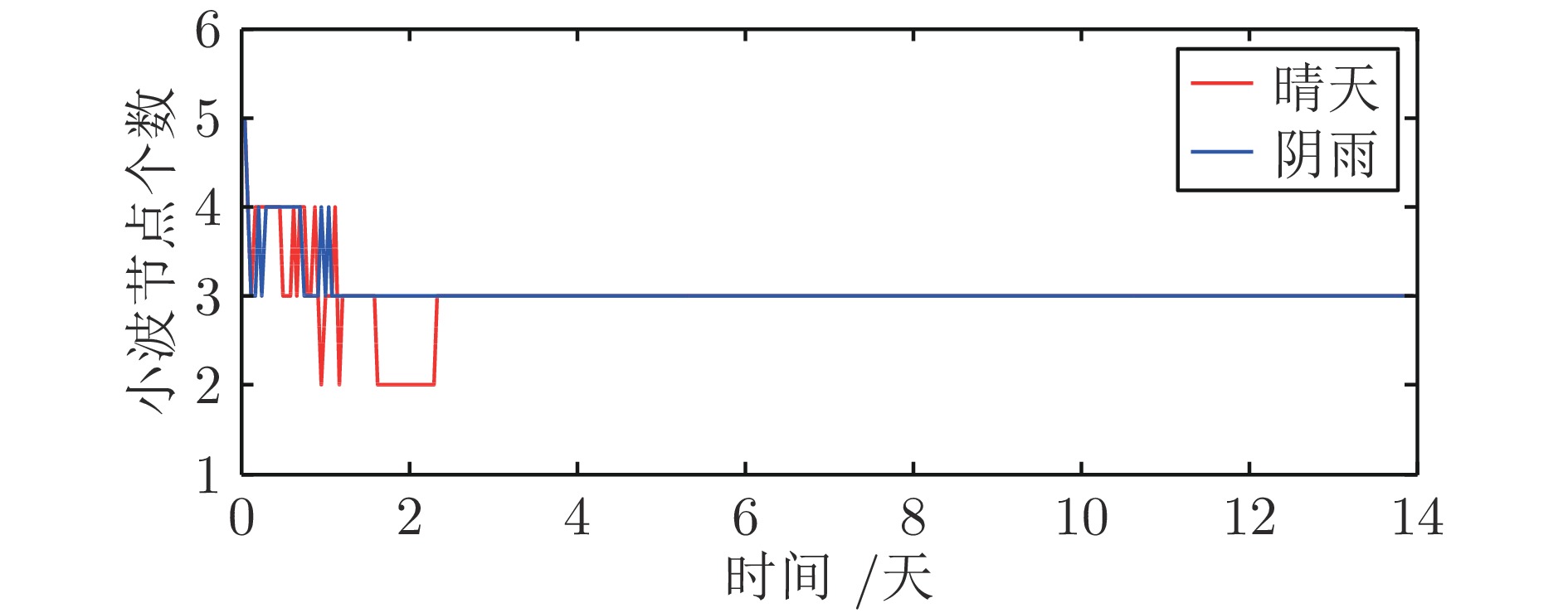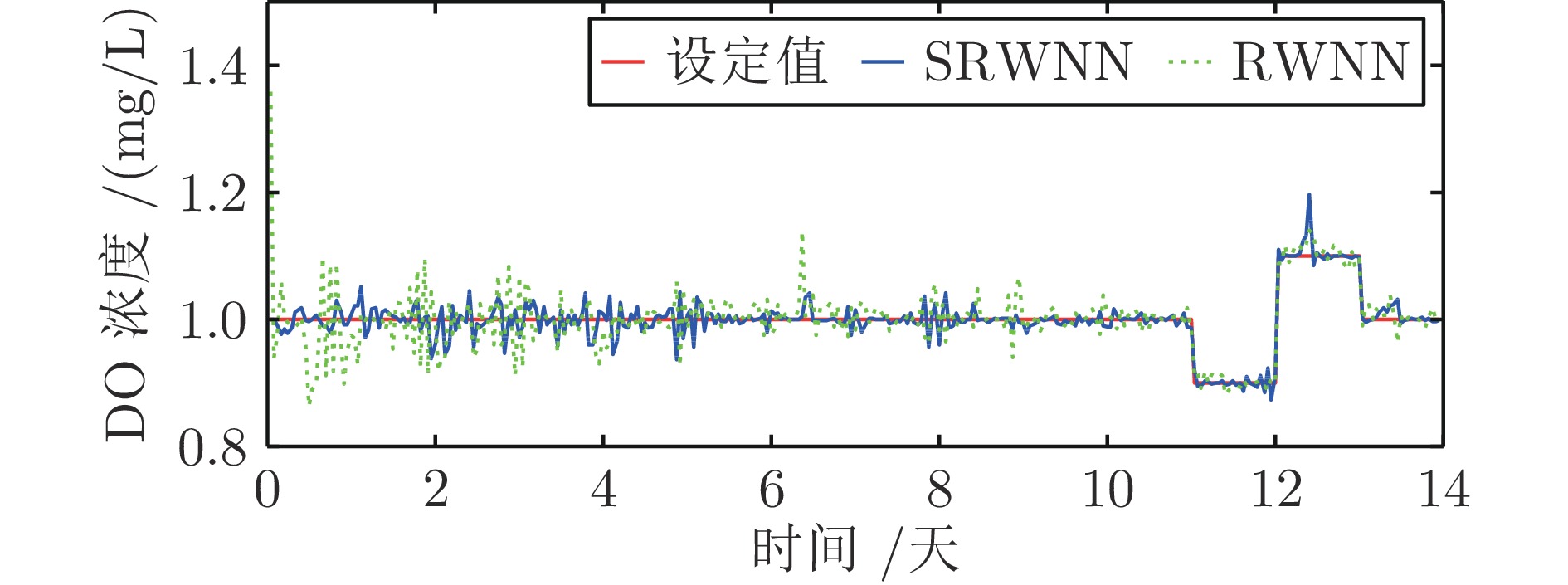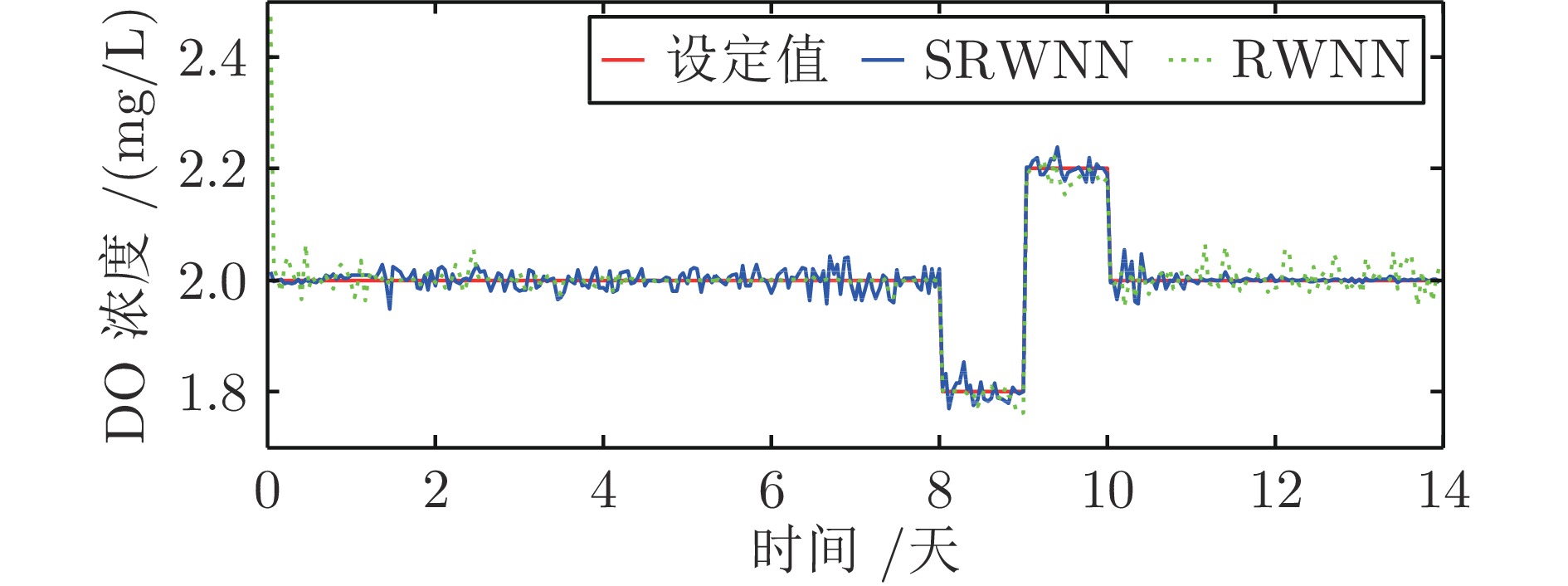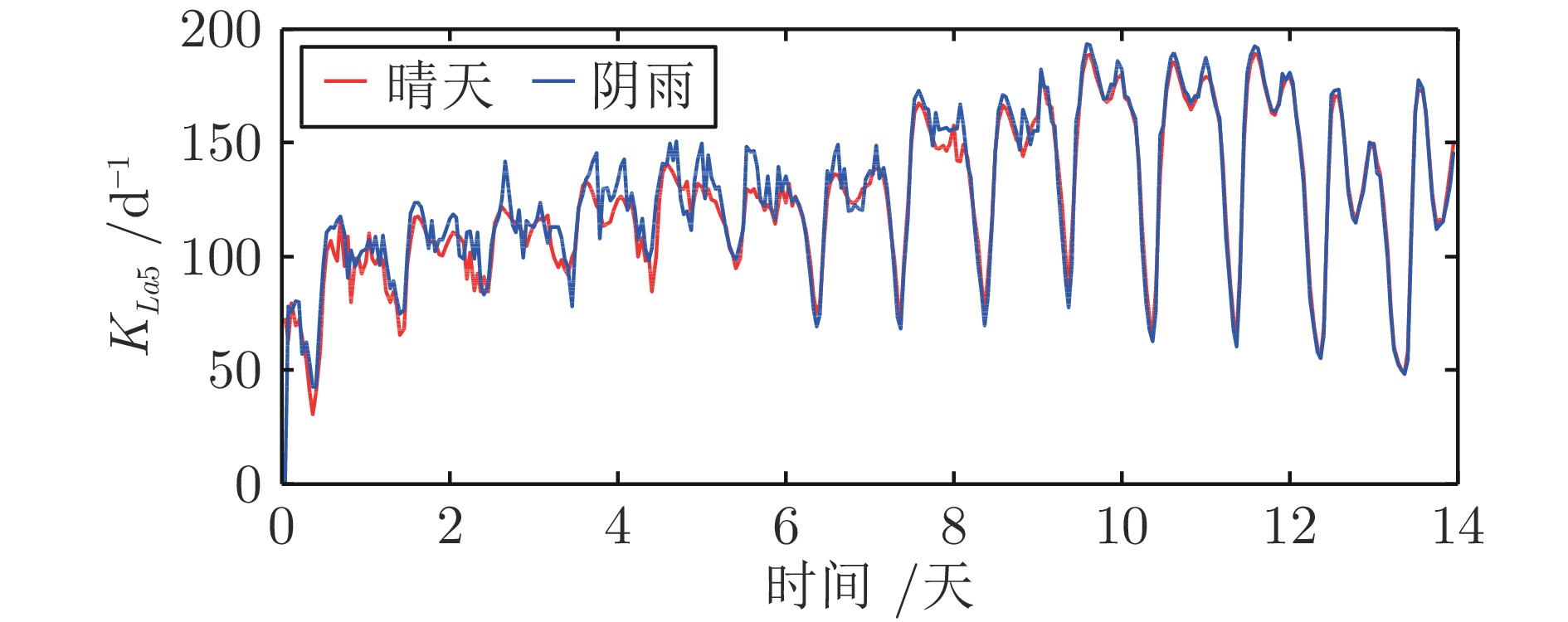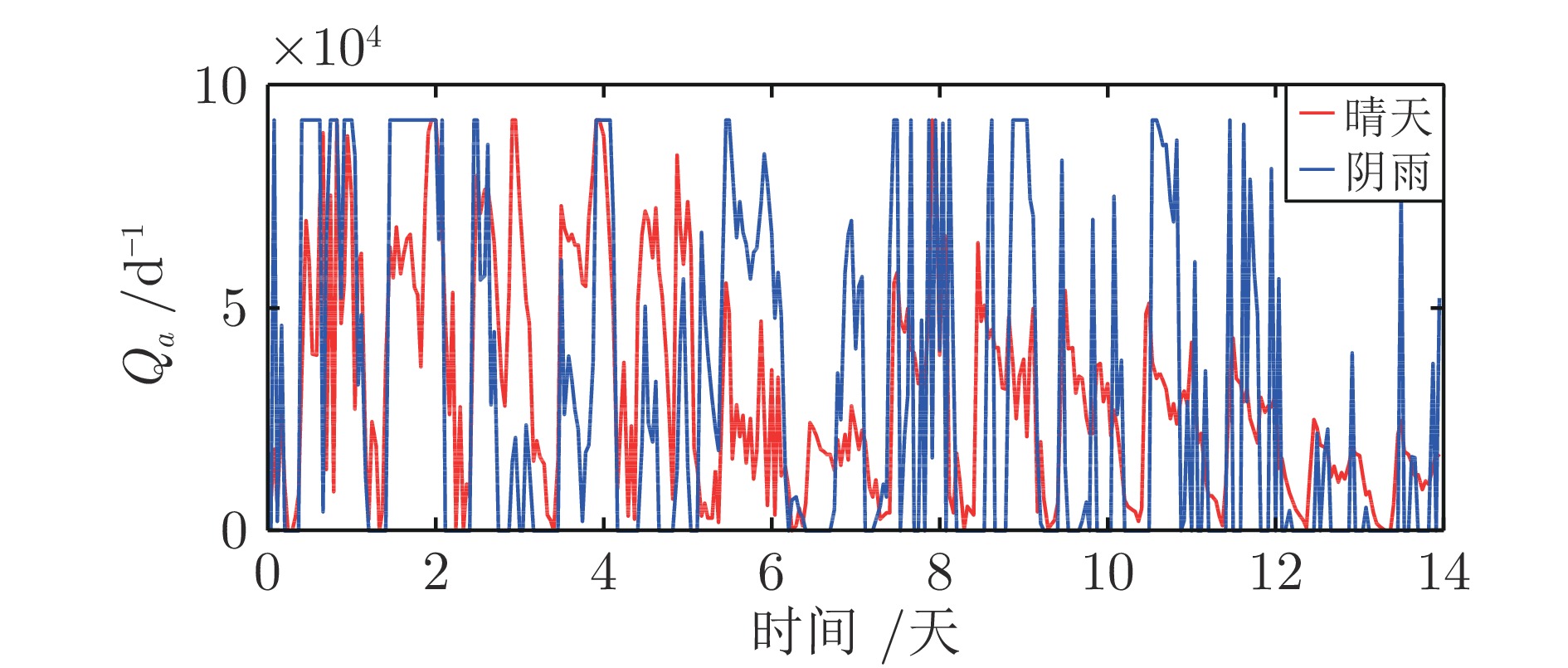Multivariate Control of Wastewater Treatment Process Based on Self-organized Recurrent Wavelet Neural Network
-
摘要: 污水处理过程是一个包含多个生化反应的复杂过程, 具有非线性和动态特性. 因此, 实现污水处理过程的精准控制是一项挑战. 为了解决这个问题, 提出一种基于自组织递归小波神经网络的污水处理过程多变量控制. 首先, 针对污水处理过程的动态特性, 根据小波基的激活强度设计了一种自组织机制来动态调整递归小波神经网络控制器的结构, 提高控制的性能. 然后, 采用结合自适应学习率的在线学习算法, 实现控制器的参数学习. 此外, 通过李雅普诺夫稳定性定理证明了此控制器的稳定性. 最后, 采用基准仿真平台进行仿真验证, 实验结果表明, 此控制方法可以有效提高污水处理过程的控制绝对积分误差和平方误差积分的精度.Abstract: The wastewater treatment process is a complex process containing multiple biochemical reactions with nonlinear and dynamic characteristics. Therefore, it is a challenge to achieve accurate control of the wastewater treatment process. To solve this problem, a multi-variable control of wastewater treatment process based on the self-organizing recurrent wavelet neural network is proposed. Firstly, to deal with the dynamicity of wastewater treatment process, according to the firing strength of the wavelet base, the self-organizing mechanism is designed to dynamically adjust the structure of the recurrent wavelet neural network controller to improve the control performance. Then, an online learning algorithm combined with adaptive learning rate is used to learn the parameters of controller. In addition, the stability of the controller is proved by the Lyapunov stability theorem. Finally, the benchmark simulation platform is used to conduct simulation.The experimental results show that this control method can effectively improve the integral of absolute error and integral of squared error of the wastewater treatment process.
-
表 1 不同控制方法在恒定设定值时的性能比较
Table 1 Performance comparison of different control methods at constant set-point
工况 控制器 No. DO NO IAE ISE $ \text{Dev}^{\text{max}} $ IAE ISE $ \text{Dev}^{\text{max}} $ 晴天 SRWNN 3 5.66×10-4 1.63×10-6 0.0087 0.0036 7.61×10-5 0.0114 RWNN 5 0.0017 3.26×10-5 0.0526 0.002 3.06×10-5 0.054 NNOMC 10 0.0390* 5.31×10-4* 0.0725* 0.0490* 7.18×10-4* 0.1630* RARFNNC 4 0.0073* 1.61×10-4* 0.0104* 0.0126* 2.83×10-4* 0.1050* DRFNNC 6 0.0079* 1.82×10-4* 0.0154* 0.0085* 3.25×10-4* 0.0176* 阴雨 SRWNN 4 0.0041 1.75×10-4 0.1042 0.0101 9.80×10-4 0.1291 RWNN 5 0.0051 2.21×10-4 0.1434 0.0117 1.40×10-3 0.2244 PID — 0.0016 1.90×10-3 0.2038 0.0317 8.23×10-3 0.3233 注: “$ \star $”表示原文中的结果, “—”表示无 表 2 不同控制方法在变化设定值时的性能比较
Table 2 Performance comparison of different control methods at changed set-point
工况 控制器 No. DO NO IAE ISE $ \text{Dev}^{\text{max}} $ IAE ISE $ \text{Dev}^{\text{max}} $ 晴天 SRWNN 3 0.0067 3.68×10-6 0.0156 0.0061 1.64×10-4 0.0067 RWNN 5 0.0087 2.62×10-4 0.1156 0.0126 2.30×10-3 0.1116 PID - 0.0127 2.38×10-3 0.1038 0.0271 4.90×10-3 0.2184 阴雨 SRWNN 3 0.0047 1.10×10-4 0.0538 0.0065 3.18×10-4 0.1527 RWNN 5 0.0069 1.92×10-4 0.0644 0.0088 4.58×10-4 0.1781 RFNNC — 0.0240* 2.40×10-3* 0.0863 0.0260* 1.00×10-3* 0.1881* 注: “$ \star $”表示原文中的结果, “—”表示无 -
[1] Tang W Z, Pei Y S, Zheng H, Zhao Y, Shu L M, Zhang H. Twenty years of China's water pollution control: Experiences and challenges. Chemosphere, 2022, 295: 133875. doi: 10.1016/j.chemosphere.2022.133875 [2] 杨翠丽, 武战红, 韩红桂, 乔俊飞. 城市污水处理过程优化设定方法研究进展. 自动化学报, 2020, 46(10): 2092-2108. doi: 10.16383/j.aas.c200294Yang C L, Wu Z H, Han H G, Qiao J F. Perspectives on optimal setting methods for municipal wastewater treatment processes. Acta Automatica Sinica, 2022, 46(10): 2092-2108. doi: 10.16383/j.aas.c200294 [3] Lizarralde I, Fernandez-Arevalo T, Brouckaert C, Vanrolleghem P. A new general methodology for incorporating physico-chemical transformations into multi-phase wastewater treatment process models. Water Research, 2015, 74: 239-256. doi: 10.1016/j.watres.2015.01.031 [4] 潘南全. 基于前馈控制模型的生化反应池曝气控制优化. 工业控制计算机, 2015, 88(1): 58-59. doi: 10.3969/j.issn.1001-182X.2015.01.027Pang N Q. Optimization aeration controI of reaction tank based on feed forward controI model. Industrial Control Computer, 2015, 88(1): 58-59. doi: 10.3969/j.issn.1001-182X.2015.01.027 [5] Du S L, Yan Q S, Qiao J F. Event-triggered PID control for wastewater treatment plants. Journal of Water Process Engineering, 2020, 38: 101659. doi: 10.1016/j.jwpe.2020.101659 [6] 曾春霞, 董宗哲, 何涛. 模糊代数PID控制在污水处理溶解氧控制系统的应用. 化工自动化及仪表, 2021, 48(6): 528-534. doi: 10.3969/j.issn.1000-3932.2021.06.003Zeng C X, Dong Z Z, He T. Application of fuzzy algebra PID control in dissolved oxygen control system of wastewater treatment. Control and Instruments in Chemical Industry, 2021, 48(6): 528-534. doi: 10.3969/j.issn.1000-3932.2021.06.003 [7] 刘锁清, 刘少红, 李军红, 彭伟娟. 基于模糊自整定PID串级控制的废水处理PH值控制. 自动化技术与应用, 2019, 38(2): 22-27. doi: 10.3969/j.issn.1003-7241.2019.02.006Liu S Q, Liu S H, Li J H, Peng W J. Wastewater treatment PH value control based on fuzzy self-tuning PID cascade control. Techniques of Automation and Applications, 2019, 38(2): 22-27. doi: 10.3969/j.issn.1003-7241.2019.02.006 [8] Hoang B L, Tien D N, Nguyen P H. Dissolved oxygen control of the activated sludge wastewater treatment process using Hedge Algebraic control. 2014 7th International Conference on Biomedical Engineering and Informatics, 2014: 827-832. [9] 许进超, 杨翠丽, 乔俊飞, 马士杰. 基于自组织模糊神经网络溶解氧控制方法研究. 智能系统学报, 2018, 13(6): 905-912. doi: 10.11992/tis.201801019Xu J C, Yang C L, Qiao J F, Ma S J. Dissolved oxygen concentration control method based on self-organizing fuzzy neural network. CAAI Transactions on Intelligent Systems, 2018, 13(6): 905-912. doi: 10.11992/tis.201801019 [10] Wang D, Ha M M, Qiao J F. Data-driven iterative adaptive critic control toward an urban wastewater treatment plant. IEEE Transactions on Industrial Electronics, 2020, 68(8): 7362-7369. [11] Nawaz A, Arora A S, Yun C M, Lee J J, Lee M. Development of smart AnAmmOx system and its agile operation and decision support for pilot-scale WWTP. Soft Computing Techniques in Solid Waste and Wastewater Management, 2021: 423-7454. [12] 韩红桂, 张璐, 卢薇, 乔俊飞. 城市污水处理过程动态多目标智能优化控制研究. 自动化学报, 2021, 47(3): 620-629. doi: 10.16383/j.aas.c190154Han H G, Zhang L, Lu W, Qiao J F. Research on dynamic multiobjective intelligent optimal control for municipal wastewater treatment process. Acta Automatica Sinica, 2021, 47(3): 620-629. doi: 10.16383/j.aas.c190154 [13] 乔俊飞, 韩改堂, 周红标. 基于知识的污水生化处理过程智能优化方法. 自动化学报, 2017, 43(6): 1038-1046. doi: 10.16383/j.aas.2017.c170088Qiao J F, Han G T, Zhou H B. Knowledge-based intelligent optimal control for wastewater biochemical treatment process. Acta Automatica Sinica, 2017, 43(6): 1038-1046. doi: 10.16383/j.aas.2017.c170088 [14] Vega P, Revollar S, Francisco M, Martin J M. Integration of set point optimization techniques into nonlinear MPC for improving the operation of WWTPs. Computers and Chemical Engineering, 2014, 68(4): 78-95. [15] Han H G, Liu H X, Li J M, Qiao J F. Cooperative fuzzy-neural control for wastewater treatment process. IEEE Transactions on Industrial Informatics, 2021, 17(9): 5971-5981. doi: 10.1109/TII.2020.3034335 [16] Ffm E S, Abuhasel K A. Adaptive nonlinear disturbance observer using double loop self-organizing recurrent wavelet-neural-network for two-axis motion control system. IEEE Transactions on Industry Applications, 2017, 54(1): 764-786. [17] 王桐, 邱剑彬, 高会军. 随机非线性系统基于事件触发机制的自适应神经网络控制. 自动化学报, 2019, 45(1): 226-233. doi: 10.16383/j.aas.2018.c180404Wang T, Qiu J B, Gao H J. Event-triggered adaptive neural network control for a class of stochastic nonlinear systems. Acta Automatica Sinica, 2019, 45(1): 226-233. doi: 10.16383/j.aas.2018.c180404 [18] Liu Y J, Li J, Tong S, Chen L P. Neural network control-based adaptive learning design for nonlinear systems with full-state constraints. IEEE Transactions on Neural Networks and Learning Systems, 2016, 27(7): 1562-1571. doi: 10.1109/TNNLS.2015.2508926 [19] Lee C H, Chang H H. Output recurrent wavelet neural network-based adaptive backstepping controller for a class of MIMO nonlinear non-affine uncertain systems. Neural Computing and Applications, 2014, 24(5): 1035-1045. doi: 10.1007/s00521-012-1326-2 [20] Lin, Hong C. A novel hybrid recurrent wavelet neural network control of permanent magnet synchronous motor drive for electric scooter. Turkish Journal of Electrical Engineering and Computer Sciences, 2015, 22: 1056-1075. [21] 张伟, 乔俊飞, 李凡军. 溶解氧浓度的直接自适应动态神经网络控制方法. 控制理论与应用, 2015, 32(1): 115-121. doi: 10.7641/CTA.2015.40311Zhang W, Qiao J F, Li F J. Direct adaptive dynamic neural network control for dissolved oxygen concentration. Control Theory and Applications, 2015, 32(1): 115-121. doi: 10.7641/CTA.2015.40311 [22] Fayez F M, Ei S, Khaled A A. Self-organizing recurrent fuzzy wavelet neural network-based mixed H2/H∞ adaptive tracking control for uncertain two-axis motion control system. 2015 IEEE Industry Applications Society Annual Meeting, 2015: 1-14. [23] Han H G, Zhang L, Hou Y, Qiao J F. Nonlinear model predictive control based on a self-organizing recurrent neural network. IEEE Transactions on Neural Networks and Learning Systems, 2016, 27(2): 402-415. doi: 10.1109/TNNLS.2015.2465174 [24] Ku C C, Lee K Y. Diagonal recurrent neural networks for dynamics systems control. IEEE Transactions on Neural Network, 1995, 6(1): 144-156. doi: 10.1109/72.363441 [25] 韩广, 乔俊飞, 薄迎春. 溶解氧浓度的前馈神经网络建模控制方法. 控制理论与应用, 2013, 30(5): 585-591. doi: 10.7641/CTA.2013.20773Han G, Qiao J F, Bo Y C. Feedforward neural network modeling and control for dissolved oxygen concentration. Control Theory and Applications, 2013, 30(5): 585-591. doi: 10.7641/CTA.2013.20773 [26] Qiao J F, Han G T, Han H G, Chai W. Wastewater treatment control method based on a rule adaptive recurrent fuzzy neural network. International Journal of Intelligent Computing and Cybernetics, 2017, 2: 94-110. [27] Qiao J F, Han G T, Han H G, Yang C L, Chai W. Decoupling control for wastewater treatment process based on recurrent fuzzy neural network. Asian Journal of Control, 2018, 21(3): 1270-1280. [28] 韩改堂, 乔俊飞, 韩红桂. 基于自适应递归模糊神经网络的污水处理控制. 控制理论与应用, 2016, 33(9): 1252-1258. doi: 10.7641/CTA.2016.50965Han G T, Qiao J F, Han H G. Wastewater treatment control method based on adaptive recurrent fuzzy neural network. Control Theory and Applications, 2016, 33(9): 1252-1258. doi: 10.7641/CTA.2016.50965 -

 点击查看大图
点击查看大图
计量
- 文章访问数: 38
- HTML全文浏览量: 20
- 被引次数: 0



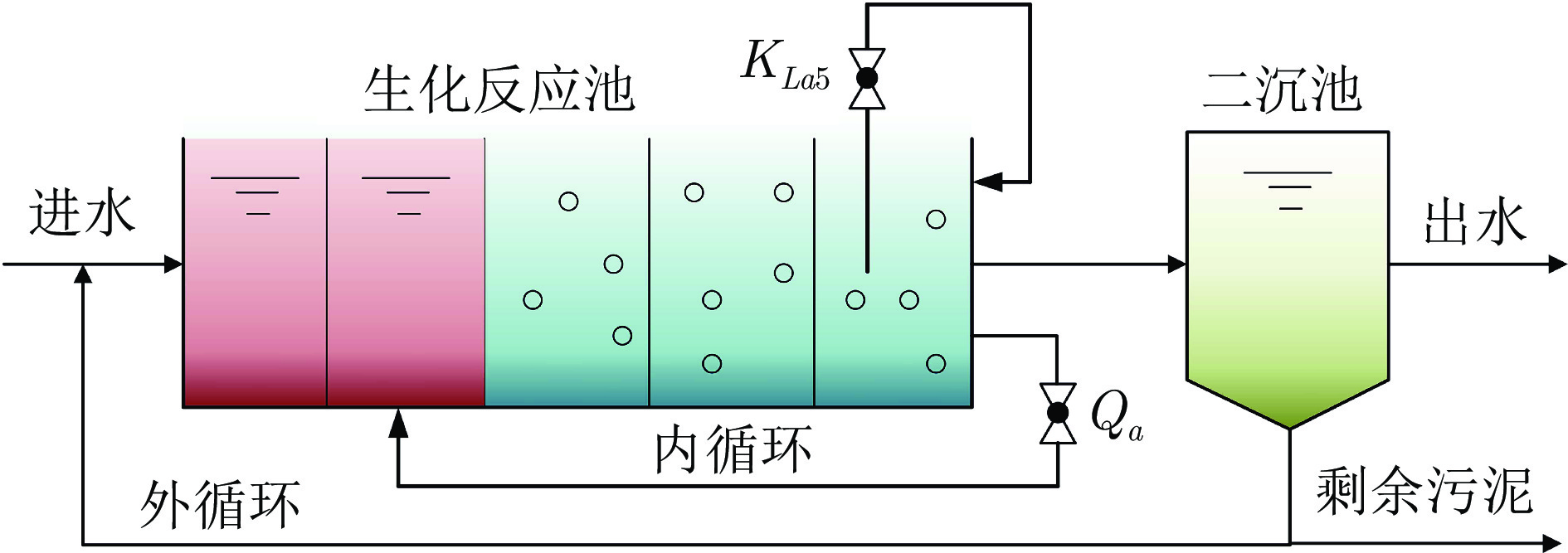
 下载:
下载:


